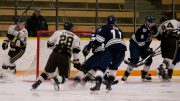The sun-drenched metropolis of Phoenix, Arizona is a sporting paradise, justifiably benefitting from its balmy climate with such activities as year-round golfing in courses nestled by palm trees and challenging hiking trails. In addition, the city is known for its gauntlet of sporting teams, including but not exclusively, all four professional team sports, the MLB’s spring training festival known as the Cactus League, a thriving athletics program at Arizona State University, plus events like the NASCAR Sprint Cup Series, the PGA Tour, college football’s Fiesta Bowl and even a WNBA team sprinkled in for good measure. In fact, a trip to Phoenix would be a bonanza to any sporting fan’s Christmas list; including yours truly, who has attended an NHL and an NBA contest there.
However, upon my first impression of the locals` preferred sporting options, it seems there may be too many choices for the entertainment dollar given the economic climate, as not even the NBA appears exempt.
The NHL’s Phoenix Coyotes have always been the odd one out in the Arizona sports scene. At least ever since the lacrosse team fled and the arena football team ceased operations until Spring 2010 in a reorganized league. Though to give Arizonians credit, their neglect is understandable due to the entire lack of ice in the region — you do not need to be in academia to piece those factors together.
I — maybe because I lack common sense — have been an unabashed booster for the Desert Dogs, largely because the fan base needs the opportunity to be re-energized in a market that hasn’t seen a playoff game since the 2001-02 season. A winning season might finally put the doubters to rest.
The squad’s attendance woes are a shame particularly because the rink is gorgeous. Built in 2003, the arena has anyone whose walked the crammed corridors of the MTS Centre immensely jealous, as there is plenty of breathing room in the Jobing.com Arena — and not because the rink is often nowhere near capacity. In fact, the building was half full. When I was there, the longer sides of the arena were above 70 per cent capacity, but the far ends were abandoned with many back-to-back rows completely bare. However, the Coyotes strategically placed a majority of the fans who bought lower-bowl tickets in the bottom rows, in the effort to pull wool over the eyes of TV viewers believing more people are attending than there really are.
Ticket prices were cheap. My family bought three lower-bowl and two upper-bowl tickets for a grand total of $150. We may or may not have been helped along by a scalper (the Manitoban does not condone such activities). With tickets in hand, we sneaked past an usher checking the vouchers to allow the five of us to enter the lower-bowl with just three valid tickets.
Though the ‘Yotes dominated the Anahiem Ducks, the game was a blast. And the fans, while small in numbers, were animated and familiar with the sport. Demonstrating to me, at least, that there is hope for hockey in the desert.
From a half-full hockey rink, a sold out, high-intensity atmosphere at the basketball game was my expectation when we later trekked to an NBA game on Christmas Day. With the Suns as one of the league’s leading franchises, plus kids being off of school, frigid Northern tourists searching for sun and the biggest regular season date on the NBA schedule, Christmas Day, I surely figured, would lead to a capacity crowd at the U.S. Airways Arena. I was corrected. As nearly 2,000 empty seats dotted the stadium in an entertaining blowout over the Los Angeles Clippers.
Mind you, the Clippers are not one of the NBA’s foremost franchises, but this was Christmas Day. The Association’s finest showcase of the season outside of the playoffs — where the biggest names and biggest teams battle in a day steeped with tradition, wall-to-wall coverage of the quintuple header from ESPN/ABC and fancy Christmas-style kicks. But the building did not sell out, and instead embarrassed themselves on the American stage while the other premier games were played to packed arenas.
Though my perspective beforehand may appear full of doom and gloom, Phoenix is still a thriving sports town. The fact that they house numerous sports events should attest to that. Nevertheless, the economy is in a trench, with less locals willing to fork over the cash for expensive luxuries. This, of course, is disadvantageous to the already menacing situation for the Coyotes, and helped ruin a home sell-out streak of 153 games for the Suns. When Phoenix has trouble selling out a marquee basketball team with NBA superstar Steve Nash during the holidays, you know a problem exists.
High ticket prices should also be investigated as a potential cause for concern. Having lost fistfuls of cash, the Coyotes cannot drop prices farther; however, when admission to the lower-bowl at Suns games can reach upwards of $330, they may have priced themselves out of the league for the average middle-income family. Especially considering Arizonans can watch all Suns games in HD on the couch for a respectable cost.
With the economy’s dilemmas, sporting events are suffering like virtually every other industry. In truth, maybe the only league immune is God’s gift to sports, the billion-dollar enterprise that is the National Football League.




